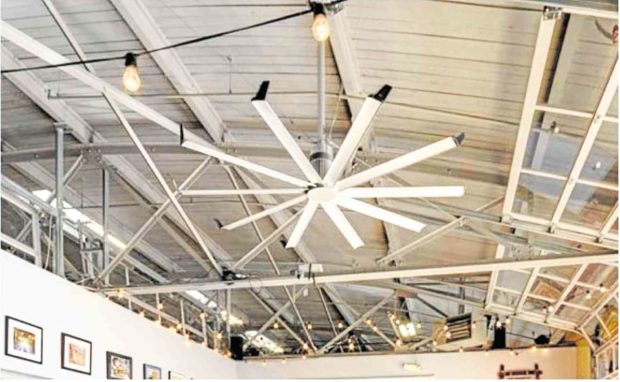
Ten years ago, Liza Morales-Crespo founded Philippine Geogreen Inc.—a source of sustainable and environmentally responsible building applications for home, commercial and industrial use. She literally had to knock on the doors of potential clients to present products that seemed to come straight out of science fiction books.
There was Solatube, a system engineered to harness the sun’s rays and bring them into the home to lend brighter, more expansive interiors.
There was Haiku, small ceiling fans whose award-winning silent motor and controls generate a cooling effect 80 percent more efficient than conventional ceiling fans.
There was also the Atmospheric Water Generator (AWG), which creates water out of air. (Water vapor in the air is condensed by cooling the air below its dew point, extracting water in the process.) The water becomes potable after undergoing multiple stages of filtration.
The biggest curiosity, in more ways than one, was the appropriately-named Big Ass Fans.
Founded in 1999 in Lexington, Kentucky, and inspired by people who described them (“Are you the ones who make those big-ass fans?”), the massive, energy-efficient ceiling fans operate on high-volume, low-speed technology—meaning, they circulate a great amount of air in a room even as they spin slowly.
Guinea pig
“When we started out with this new and emerging technology, nobody wanted to be
the first one to use it,”
says Morales-Crespo. “Nobody wanted to be the guinea pig.”
What a difference a decade makes. Today, Big Ass Fans have become familiar fixtures in churches, gyms, factories and other large spaces.
Haiku has come up with its new-generation fans, models that can be controlled with the virtual assistant Alexa, or can automatically turn on and off as people enter and leave a room.
“Our residential market used to be such a small sliver of the pie. Now it’s catching up on our commercial and industrial markets. We actually had to
set up a separate sales department just to handle residential clients,” she says.
New innovations
As the demand for environmentally responsible products grows, Philippine Geogreen continues to roll out new innovations, each one more amazing and unthinkable than the last.
The company’s 10th anniversary celebration last April introduced exciting products that fall under one of the four elements: fire, air, water and earth. (Solatube is fire; Big Ass Fans and Haiku are air; and the AWG is water.)
From the fire category is DryWired, maker of thin-film paint coatings with nanotechnology. Activated by natural and artificial light, nanotechnology in the coating system has the capacity to break down smog and other airborne pollutants.
Applied on building exteriors (concrete and glass), buses and a variety of surfaces, DryWired cleans air and repels water, extending the life span of the surfaces it protects.
Filed under the category of earth is Shorelock, technology that preserves and restores coastlines by doing away with dredging, or transporting sand from one place to another.
Ideal for beaches, resorts and islands whose shore doesn’t have fine sand, Shorelock uses a biodegradable chemical compound, a slimy substance that is applied about 12 inches below the high tide line of the sand. In a matter of months, a once craggy beach is slowly transformed to a powdery one.
BioCleaners are a new addition to the water category. Microbes, or good bacteria, eat the sludge in wastewater, elevating it to clean and odorless water that can be classified as recycle or even drinking grade. Philippine Geogreen has already applied BioCleaners in a few factories as well as some resorts in Cebu.
Sustainable practices
Morales-Crespo, an architect who has dedicated her eponymous firm to the design of green buildings and the implementation of sustainable practices, has also seen her company’s portfolio expand in recent years.
Of late, Liza Crespo Ecotecture (LCE) has completed a resort, bed and breakfast, and a sports complex. The company was also behind Bo’s Coffee Headquarters in Makati, select branches of Cyma, Green Pastures, Urban Ashram and Press by Fully Booked, among others.
Misconception
Still, some things haven’t changed in the last 10 years. To this day, the public continues to perceive anything green or eco-friendly as expensive, which is a misconception, says Morales-Crespo.
“It’s a matter of educating the client. Rotating a building this way or that way costs the same amount of money. We’re just doing it smartly to take advantage of the natural breeze and to avoid orienting the house to where the sun is at its hottest. We just ask that clients have an open mind to explore possibilities with us.”
The architect also notes how clients demand green products not so much for how they preserve the environment but for how much money they can save for their company.
“When they hear words like ‘energy-saving,’ ‘lowering your capital expenditure,’ and it’s going to help your bottom line,’ they’re like, ‘Okay, you’re speaking our language,’” she says. “It’s a sad reality that you have to present your products that way, but slowly they see the benefits of having green products.”
Morales-Crespo remains hopeful that people will eventually turn to and appreciate green products for their intended purpose. “I’m hoping there will be a paradigm shift, where people will start thinking of the environment and that will be their motivation [for buying eco-friendly products] versus the savings.
“I see a lot of potential for the Philippine market to keep growing,” she says. “We have the highest per-kilowatt-hour rate in Asia, and geographically, we feel the effects of climate change more than other countries in Asia. I hope people will realize the importance of being more sustainable and responsible.” —CONTRIBUTED
https://philgeogreen.com